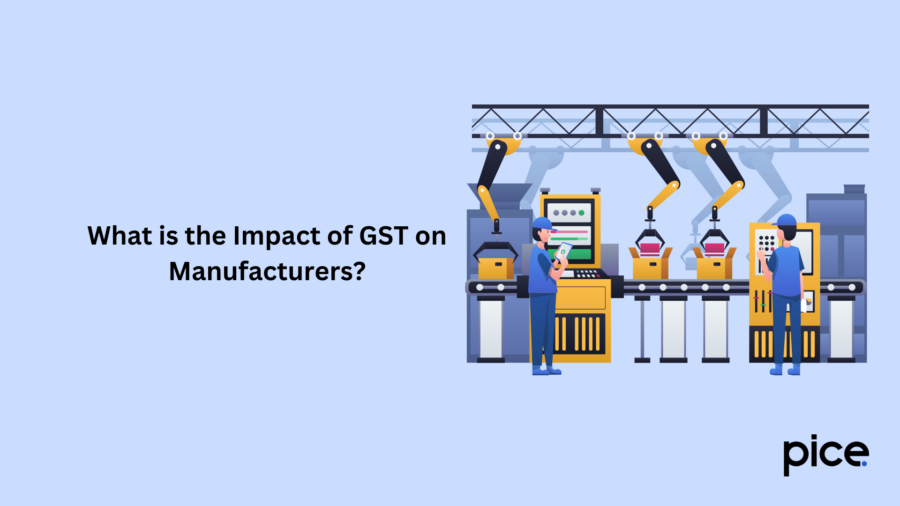A Guide on Impact of GST on Manufacturing Sector
- 12 Feb 25
- 17 mins

A Guide on Impact of GST on Manufacturing Sector
Key Takeaways
- Simplified Taxation: GST replaced multiple indirect taxes, streamlining compliance.
- Cost Savings: Lower logistics costs and seamless interstate trade boost profitability.
- No Tax Cascading: Input Tax Credit (ITC) reduces the overall tax burden.
- Enhanced Competitiveness: A unified tax system helps manufacturers expand and innovate.
- Stronger Compliance: Digital record-keeping ensures transparency and efficiency.
The introduction of the Goods and Services Tax (GST) into the Indian economy has led to an undeniable improvement in the country’s tax collection system. It completely remodeled the taxation landscape here. With that, the need arose for manufacturers to legally comply and operate in cooperation.
This blog shall highlight the impact of GST on the manufacturing sector, deep-diving into key areas that define said taxation ecosystem from the manufacturers’ perspective.
The GST has replaced several indirect taxes to serve as a single tax obligation. Additionally, the system has helped streamline processes and simplify compliances. Therefore, the impact of GST on the manufacturing sector has been up to a degree, which cannot be ignored.
From reduced logistic costs to enhanced efficiency in the supply chain, there are several benefits reaped by the manufacturer. So, let's get started!
What is the Impact of GST on Manufacturers?

Here are some points of impact that the GST has had on the manufacturing sector:
- Streamlined Tax System: In the pre-GST era, there was a complicated and rather fragmented tax system in place, involving multiples of indirect taxes. With the inception of GST in India, the goal has remained singular, which was to bring forth a streamlined and unified tax structure. This process eliminated the unnecessary requirement of having to navigate a multitude of taxes—thus, achieving the set goal. It led to the implementation of a taxation system, which is much more comprehensible and transparent for the manufacturing industry.
- Reduction in the Manufacturing Bills: A major benefit that the manufacturers under GST were able to help themselves to was the reduction in logistics bills. The easy movement of goods across state borders and no hindrance posed by multiple entry taxes allowed for more efficient and cost-effective dealing. Reduction in logistics costs served as a major source of profitability for the manufacturing industry.
- Enhanced Efficiency in the Supply Chain: The introduction of GST in India has had a notable impact on the dynamics of supply chains. With entry taxes becoming irrelevant and the uniform tax rate coming into force across states has cleared up communication channels for seamless interstate transactions. This has led to improved efficiency in the supply chain, reducing potential delays and bottlenecks at the state borders. Thus, manufacturers are able to operate productively.
- Reduction in Tax Cascading: Another major benefit for manufacturers resulting from the implementation of GST is the elimination of tax cascading. This phenomenon can also be phrased as "tax on tax". The former tax regime caused manufacturers to encounter the challenges of having to pay taxes on the total value of products at every stage of production. However, GST taxes are levied only upon the value added at every stage. This helps avoid the accumulation of taxes at a single stage.
- Enhancement of Competitiveness: A simplified tax structure is the defining characteristic of GST in India. This, in combination with the elimination of barriers to interstate trade, has led to intensified competitiveness throughout the manufacturing industry. Prompting a reduction in compliance burdens as well as operational complexities, the manufacturers are able to shift their focus on bettering the quality of their products. They are further able to explore new markets and strengthen their competitive edge.
- Input Tax Credit Advantages: GST has brought in the concept of ITC (Input Tax Credit). It allows manufacturers to claim credit against the GST amount paid on their input goods and services supply, which includes investment in raw materials. This assures the manufacturer that the taxes paid for raw materials/other inputs are offset against a final tax liability on the finished item. ITC minimizes the overall tax burden on the manufacturing sector, shifting the obligation to the consumer to some extent.
- Enhanced Compliance & Documentation Requirement: The Indian GST structure mandates a digitized and composed approach towards documentation and compliance. Therefore, the manufacturers need to keep updated and detailed records of transactions made. This ensures transparency while also facilitating compliance. While the process may appear complicated at first, the digital shift to online documentation ultimately becomes much more convenient, promoting a well-organized and accountable environment for businesses to flourish.
- Impact upon the Small and Medium-Scale Manufacturers: The implementation of GST in India has had a mixed-natured impact on small and medium-scale manufacturers. The initial adjustment period is characterized by a few challenges when it comes to compliance. Yet, the introduction of the composition schemes has simplified the compliance procedures, after all, aimed at easing up the transition for medium-sized/smaller manufacturers. This is marked as a remarkable endeavor by the GST, attempting to level the playing field for multi-level businesses.
Thus, we can conclude that the impact of GST has demonstrated a transformative journey lined with transparency, efficiency, and competitiveness for the business environment. Next, find out how GST is levied on manufacturers’ products.
Is GST levied on Manufacturers?

GST is, indeed, levied on manufacturers who are in business within India. This indirect tax is a destination-based tax, which applies to the value of goods and services, inclusive of those that are part of the manufacturing units.
Now, for context on how the GST value is applied, note that at every stage of progress in the manufacturing business, the GST rate is levied. From obtaining the raw materials to the production system and the final sale of goods, GST is calculated accordingly. This ensures a systematic taxation structure. When the final product is ready to be sold to consumers, GST is applicable again.
The GST framework considers manufacturers as key components within the supply chain, responsible not only for the production and distribution of goods but also as key collectors of GST.
The tax amount collected upon the sale of goods and services is remitted to the Indian government. Manufacturers can then claim the deduction of the input tax credit, i.e. the GST initially paid on procuring the raw materials and other inputs in the first place, at the production stage.
What is GST in Manufacturing?
The phrase 'GST in manufacturing' is associated with various traceable implications. It signifies a remarkable shift in the taxation methodology of India. Implementation of GST aimed to, and successfully, ensure fair/streamlined taxation from the very early stages of production up to the point of final goods reaching customers. This has consequently led to the fostering of growth and efficiency within the manufacturing industry.
As you must have deduced, GST within the field of manufacturing is a crucial aspect forming a major part of the taxation system in India. It governs the production of goods in our country. This singular indirect tax has essentially replaced several complex indirect taxes (including Central Excise Duty, Central Sales Tax and more). Thus, it has simplified the taxation procedure and brought about transparency within various sectors.
GST is chargeable on the entire production process within the field of manufacturing. It includes costs related to collecting raw materials needed for goods’ production as well as the final resulting items meant for sale. Everyone who contributes to the manufacturing timeline is essentially taxed as GST is levied at each stage of the production cycle. The tax applies to raw material procurement and other components and services used throughout the production stage.
In order to produce the finished product, manufacturers infuse value into the raw materials in the form of labour and other methods. It’s important to note that GST on the finished product is calculated on the basis of added value during the manufacturing process, and not on the full sale value.
Essentially, GST in manufacturing simplifies compliance for enterprises by minimising the complexities of several taxes (previously prevailing scenario within the manufacturing field). Its primary motto is to promote accountability and transparency within the tax system. The functioning of manufacturers within the country is also enhanced in the process, fostering a sense of efficiency and growth within the sector.
What is the GST Limit on Manufacturing?

There is a GST limit on manufacturing. It is set at ₹40 lakh, the annual turnover threshold for mandatory GST registration. Businesses and companies that have turnovers below ₹20 lakh (₹10 lakh within states that are under the special category) are exempted from GST registration.
However, manufacturing companies who have an annual turnover above ₹40 lakh are required to register under GST. They are legally required to comply with the associated regulations. This limit is set with a view that seeks to balance the necessity for taxation coverage while keeping in hindsight, the practical considerations of companies in the manufacturing industry.
How Do You Calculate GST in Manufacturing?
The calculation of GST in manufacturing plays a crucial role in determining the tax amount at various stages of production as well as distribution. In order to calculate the Goods and Services Tax (GST) in manufacturing, here are the steps that one can follow:
Step 1: Determining the Taxable Value
One can start by finding out the taxable value, which is the price paid/payable for the goods and services supplied. The transaction amount is the basis on which the GST amount is collected at each production stage.
Step 2: Identifying the GST Rate
Applicable rates may vary as each category of goods and services is associated with specific GST rates. Certain products may attract very low GST rates or even be exempt from their applicability. Therefore, it is crucial to identify the appropriate GST rate associated with specific types of goods and services.
Step 3: Calculate the GST Amount
Next, you must calculate the GST amount by multiplying the taxable value by the applicable GST rate. Here is the formula to be used:
Taxable Value*(GST Rate/100) = GST Amount
Refer to the example below for better understanding:
A manufacturer produces electronic gadgets. Assume that the transaction value for the batch is ₹1,00,000. Note that the GST applicable on electronic gadgets is 18%. Here’s how the formula is applied:
Taxable Value*(GST Rate/100) = GST Amount
Input the values accurately,
₹1,00,000 × (18/100) = GST Amount
₹18,000 = GST Amount
The GST amount for the collection of electronic gadgets would amount to Rs. 18,000.
Step 4: Add GST to the Selling Price
Once the GST amount has been calculated, it is to be added to the selling price point. The total amount will be inclusive of the original cost and the GST. This price will be paid by the buyer. So, the tax burden is borne by the purchaser, the scenario being rather beneficial to the manufacturers.
Step 5: Input Tax Credit (ITC)
The runners of the manufacturing industry can claim an Input Tax Credit for the GST paid on the inputs used during the various production stages. If the manufacturer pays, for example, ₹10,000 as GST upon buying raw materials, this amount can be reclaimed later against the GST levied on the sale of the finished products.
Take the example of electronic gadget manufacturers again. While the GST applicable on the products is ₹18,000, the manufacturer ends up paying ₹10,000 as GST solely on raw materials.
The net GST liability as per calculations would be:
GST Amount on Sales − ITC on Purchases = Net GST Liability
₹18,000 − ₹10,000 = Net GST Liability
₹8,000 = Net GST Liability
The manufacturer, in this case, would only be required to pay ₹8,000 as GST (on consideration of the Input Tax Credit) to the government.
Step 6: Filing GST Returns
As the final step, the manufacturers are required to file their regular GST returns. They must provide accurate and detailed information regarding the sales and purchases made. Timely filing is important, keeping in mind the need for compliance with tax regulations for businesses.
What is the Impact of GST on the Industry Sector?
The impact of GST on the industry sector has been notably widespread, being mainly positive in nature. Here are some points of impact for factual demonstration:
- Reduction in Tax Cascading & Provision of Competitive Pricing: A major benefit resulting from the implementation of the GST system is the elimination of the tax cascading phenomenon. Companies can claim input tax credits for their purchases made during the production stages. Simultaneously getting rid of the tax-on-tax issue, businesses are able to save money and provide more competitive pricing for customers.
- Fueling the Growth of the Organized Sector: There has been a notable shift towards a formal economy, which was one of the primary goals of GST implementation. By discouraging and penalizing any case of tax evasion, GST encourages genuine businesses to join an organized arena. This shall simultaneously promote transparency as well as a fair competitive edge within the industry, boosting the overall health of a business environment.
- Simplified Tax Structure & Boosted Compliance: The introduction of GST was, from its inception, aimed at simplifying the tax structure in our country. A fragmented and complex system of tax collection confused the average society occupant, the manufacturer, in this case, having them burdened with a myriad of tax obligations. The GST substituted the multitude of indirect taxes as one indirect payable tax on goods and services. This fostered efficiency, simplicity and fairness within the industry sector.
- Enhanced Logistics and Supply Chain Efficiency: The GST system has dethroned the reign of entry taxes at state border checkpoints, which has facilitated the seamless interstate flow of goods and reduced administrative burdens. This has led to enhancement in logistics and improved supply chain efficiency. Industries that are involved in transportation and distribution have vastly benefited from the same.
- Tracing the Impact on Small to Medium Enterprises (SMEs): Large-scale companies have reaped the benefits of a streamlined tax system, especially with input tax credits. However, SMEs in the initial stages, are met with hurdles as they attempt to adapt to the new era. New degrees of compliance demands and the elaborate transition process may seem challenging at first, for smaller businesses. Such challenges can be overcome with additional support measures in place.
- Consumer Price Influence: Final consumer prices are impacted by how specific businesses pass on the advantages bagged from input tax credits and from reduced tax cascading respectively. In various cases, lowered price tags may result, in positively influencing spending on the purchasers’ end.
- Sector-Wise Impact: Various industries are likely to experience a diverse set of impacts, based on their unique work procedure. While construction and real estate, for example, may see tweaks in demand or pricing dynamics, the service industry shall undergo alterations in service tax implications—the impact cannot be generalised.
While manufacturing industries have greatly benefited from the implementation of GST, there are certain practices that the manufacturers must inculcate for even smoother operations. In the next section, we are going to dive into the same.
Best Recommended Practices for Manufacturers Under GST

Here is a list of the best practices recommended to manufacturers under the GST framework, to allow for enhanced GST compliance and transparency:
1. Maintenance of Important Records: Precise records of all categories of information must be maintained, including details surrounding various transactions (receipts, invoices, and any other relevant paperwork).
2. Accurate Classification of Goods and Services: It is essential to ensure the appropriate classification of various goods and services, as per the schedule of GST rates. Precision in this case is crucial as this step determines the exact tax liability.
3. Timely Filing of Returns: It is important that one adheres to the GST return filing schedule. This will help avoid possible penalties or late fees. Filing returns on time ensures GST compliance and helps positively contribute towards upholding a clean reputation for the business in question.
4. Adequate IT Infrastructure: Businesses should invest in IT systems that would aid the efficient management of GST compliance. For example, the utilisation of GST-compliant accounting software shall effectively help generate accurate reports and invoices. Therefore, there is an enhancement in the overall efficiency of the tax management procedure.
5. Appropriate Valuation of Goods: Manufacturers must accurately value their goods and services in order to determine the correct GST liability. By properly interpreting and applying the established valuation rules under GST, compliance shall be a piece of cake.
6. Availability of Training and Awareness: Businesses should take it upon themselves to go the extra mile by providing training and boosting all-around awareness among workers. If the staff is up to date with the GST regulations and are well trained, the chances of error decrease. At the same time, compliance procedures are smoothly implemented within the organization.
7. Ensuring Fair Prices for Customers: Manufacturers are required to actively abide by the anti-profiteering rules. This step entails making sure that cost savings via reduced taxes are reflected in the prices of final products available for sale to customers. In this way, manufacturers are able to meet regulatory standards while also engaging in fair business practices, benefiting both parties involved in transactions. Thus, it’s important to pass on the advantages of tax reductions to consumers.
8. Management of Input Tax Credit (ITC): Manufacturers are required to keep track of input tax credits to ensure that they are appropriately claiming refunds. This shall contribute to the overall reduction of tax liability on the manufacturer in business.
9. Regular Reconciliation of Books: By proactively and regularly reconciling the books of accounts aligning with the filed GST returns, manufacturers will be able to detect and rectify probable discrepancies promptly. This allows for the accurate maintenance of financial reporting.
10. Engaging Professional Advice: One may seek the advice of professionals within the field, like consultants or tax experts. It shall help manufacturers stay updated on any alterations in the GST regulations rulebook. If one avails professional guidance, manufacturing businesses are more likely to stay compliant with the latest GST requirements, with minimised risks of non-compliance and associated penalties.
Conclusion
Before concluding, it is important to reiterate that the implementation of Goods and Services Tax (GST) has truly changed the game for the manufacturing sector in our country.
With an advanced understanding of the impact of GST in the manufacturing sector, manufacturers shall be better able to adapt to evolving economic landscapes. They will also be able to leverage the benefits of GST and implement them as growth and increased efficiency strategies.
GST has successfully simplified the otherwise complex tax structures, led to a reduction in logistics costs, improved supply chains, and fueled competitiveness among manufacturers in business. To smoothly navigate GST compliance, it is important to explore GST’s impact, the calculation processes, and limits as well as the best practices, which aid manufacturers effectively.
💡If you want to streamline your payment and make GST payments via credit card, consider using the PICE App. Explore the PICE App today and take your business to new heights.
 By
By 
















